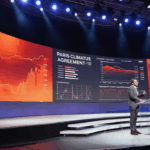As we’re on our way to 2020, many companies are scratching their heads to update sustainability plans with 2020+ targets. Here are 5 tips to make it trusted and impactful for business and stakeholders.
We All Need to Work Harder, and Accelerate on Impact to Actively Contribute to the 2030 Global Goals
Let’s be fair: sustainability strategies developed across the past decades have helped investors and companies to make significant progress across many of their Environmental, Social and Governance priorities. With a baseline 2010 or so, many large companies can claim to have significantly decreased their carbon emissions for instance. There are impressive examples of large companies which can claim to have decreased by 50% or more their emissions across the past decade. Some critical stakeholders would argue these companies have overall made progress on the easiest part. Science has been crystal clear since the early 1990’s: emissions are growing and contribution of finance and business is unsatisfactory to mitigate climate change. Good progress to date does not mean there has been enough progress to date.
From a climate risk mitigation perspective, the way forward is clear: to change trajectory sufficiently we need nothing short of a transformation of the global economy. And the same rational can apply across most if not every priority ESG topic relevant for investors and companies. Biodiversity. Water. Plastics. Human Rights for instance.
“Sustainability strategies embarking companies in 2020+ targets must show clear pathway building on lessons learned from performance to date to accelerate and demonstrate trusted capacity to seriously contribute to the broad 2030 Global Goals”
5 Tips to Update Sustainability Strategies With 2020+ Targets
So as companies and investors are defining or updating sustainability strategies and defining 2020+ targets, they certainly need to ask themselves a few questions:
For the decade to come, key opinion formers (e.g.: youth, iconic people from sport or entertainment businesses) and stakeholders (e.g.: regulators, investors) will be increasingly vocal to hold companies and finance responsible for insufficient management or their negative ESG impacts. We can expect carbon, plastic, gender among other ESG topics to put growing pressure on companies and investors year after year. This can usefully create a feeling of emergency to leverage a sustainability strategy refresh, and ensure it is seriously managed across the organization and its leadership
In response, how companies and investors’ products and services are resilient, and capable to remain acceptable and competitive for clients and markets? A sustainability strategy is not solely defined to mitigate risks. A sustainability strategy can also help to drive transformations and adapt products and practices to market environments witnessing profound social and regulatory changes from an ESG perspective
And in view of the changes at play for stakeholders, how companies and investors can actually seize opportunities of the new inclusive and resilient world we need to build on our way to 2030? We generally don’t drive change solely with negative concepts and pressures. Employees, leadership team and business partners can contribute more actively to a sustainability strategy as soon as they feel the value of taking part in something positive, and greater than themselves. Active positive contribution to some of the Global Goals agenda is doubtless a good way to accelerate on ambition and transformation with a sustainability strategy
So here are 5 tips to use to define or refresh a sustainability strategy. They can guide a review of achievements to date on ESG priorities. They can help to calibrate ambition of a 2020+ sustainability strategy. They have proven to be useful to test whether a new strategy was robust enough or could be further refined.
1. Connect Business With Pertinent Global Goals
The UN Global Goals are doubtless generic and somewhat disconnected from many hands-on investors or business decision makers. They nonetheless have the power to connect any segment of our societies to macrotopics which are pertinent for every stakeholder. For example, companies have responsibility to invest in capacity development of their employees. That’s quality education.
Global Goals are also interconnected together. Recent United Nation Climate Change Conference held in Bonn in July 2019 called on governments and non-government organizations to fully implement the Gender Action Plan (GAP) under the UN Framework Convention on Climate Change. urging for more gender responsive climate action. Investing in Gender programs has a bearing to accelerate progress on climate action basically.
How your business is related to the Global Goals? Every goal is not a good answer. Instead, the question really is about selecting 3-5 SDGs which can set direction, and help the business to understand its purpose and the way its products and services can have a positive contribution, even at small scale, to a broad and consensual global agenda. This is a powerful way to leverage a sustainability strategy, and lead business with purpose.
2. Take Your Share Actively Contributing Solving Pertinent Global Goals by 2030
Every industrial business is capable to commit to zero tolerance with safety or zero tolerance with quality default. They know it’s hard to get there, but they feel this is the kind of goal they need to direct efforts and performance, and make the best they can to meet zero tolerance with safety and quality. Global Goals can play a similar role for virtually every business. It is fair to say most businesses have no clue how they will look like by 2030. Taking share and actively contributing solving pertinent Global Goals by 2030 will set good direction to drive and transform business meaningfully.
Let’s take examples. The “End Poverty” Global Goal is clear: Let’s eradicate extreme poverty and halve the number of people living in poverty by 2030. The “Renewable Energy” Global Goal is also clear: Every person must have access to renewable energy by 2030. These two examples can provide good inspiration for many businesses. Many businesses can take this as a direction, and work hard and harder to align practices, products and services to commit to such Global Goals. A sustainability strategy and the way a company can define 2020+ targets can align with such overarching direction.
3. Assess Performance to Date
Sustainability strategies have been developed partly as a dotted connection between companies and their stakeholders. Across the past two decades, sustainability strategies have been useful to capture stakeholders concerns and demonstrate capacity to take responsibility and improve practices and products accordingly. For the decade to come, this is clearly not going to be enough. Getting into 2020+, sustainability strategies will be trusted only if they are backed up with past data and information showing successes and failures to date.
Let’s take climate for example. Companies are increasingly committing to Science Based Targets using TCFD recommendations. They can lead trusted discussions with stakeholders, including investors, only of course if they commit and intend to decarbonize for the years to come. But they also need to share data and what they’ve learned to date to get where they are. What’s been easy. What’s been challenging. That’s how they can build trust and generate confidence with stakeholders.
4. Use ESG Standards to Connect With Stakeholders
SASB, ISO, IIRC, IASB, GRI, CDP, CDSB, TCFD, SDG Compass, ESG Rating Agency Methodologies… there are many ESG standards and rating approaches available on the market. Interestingly, this multiplicity of standards has overall not proven to have generated much mutual understanding across stakeholders. This might be surprising, but investors and sustainability departments may find it difficult to understand each other, as they are often not using same standards nor taxonomy to tackle similar ESG topics.
We are often asked to ensure that sustainability strategies can translate impactfully across ESG standards. Brands believe getting good scoring across ESG rating is good for business. This is partly true, but this is not the right way to approach and use ESG standards.
Instead, with a clear business case and contribution to the Global Goals, ESG standards should primarily help stakeholders to understand and compare information provided by companies. What matters is not to please and complete every standard. What matters is to be clear on the business case and the sustainability performance, and use ESG standards to engage constructive dialogue with stakeholders.
5. Innovate, innovate, innovate
It is very clear that companies and investors are expected to accelerate on ESG performance for the decade to come. They cannot respond to opinion formers using simply same solutions as what they have implemented to date. They cannot engage and build trusted dialogue with their stakeholders disclosing a 2020+ sustainability strategy showing business as usual ambition.
Innovation is key. Companies and investors must of course build on past performance and double down on several programs generating ESG progress to date. They also need to innovate, and demonstrate capacity to explore more disruptive approaches to accelerate their contribution to their pertinent Global Goals. Here are a few concrete areas doubtless worth exploring to innovate, innovate and innovate:
- Technology solutions. Many ESG topics are suffering from fragmentation of responsibilities across stakeholders, complexity of what needs to be improved, as well as numbers at play often reaching quickly millions of stakeholders or references or transactions. Emerging technologies offer disruptive options to connect communities of shared interests, and manage complexity and numbers in a cost effective manner. Every sustainability strategy clearly need to commit to 2020+ targets including disruptive programs showing how emerging technologies (e.g.: blockchain, Internet of Thing, Artificial Intelligence using big data) are explored to provide scalable solutions accelerating commitment of companies on their priority ESG topics
- Innovative finance solutions. Most ESG programs are suffering from insufficient mobilization of financial resources, or complex multistakeholder governance making it difficult to scale up and expand. Multiple innovative financial solutions including blended finance, sustainability themed investment programs, impact investment options, or development of targeted special purpose vehicles (SPV) can enable to mobilize more funds or provide more effective governance models ensuring design and deployment of very concrete programs accelerating achievements on priority ESG topics
- Partnerships and coalitions. Every ESG topics are suffering from insufficient alignment on problem statement, unclear taxonomy and weak working principles building more consistent practices addressing issues. Partnerships and coalitions remain useful to build momentum across communities. Every sustainability strategy clearly need to provide an assessment on successes and failures to date being involved in business partnerships and coalitions with stakeholders. Every sustainability strategy can then provide a perspective to explain how the company will expect to leverage such partnerships and coalitions differently across the years to come to accelerate momentum and impact
Conclusion: Think Transformation and Disruption to Embark Your Company on 2020+ Sustainability Strategy
It is very clear that clients, investors and other stakeholders are increasingly demanding on ESG performance. Some clients are for example seeking for low carbon solutions increasingly actively. Most investors are using ESG criteria to refresh their risk assessment approaches. Clients and investors have increasingly in common to agree that doing business in the decade to come will be very different than the way they’ve been able to do successfully business to date. They will have to become increasingly held accountable themselves for their ESG performance. They will have to navigate increasingly complex ESG regulations. They will have to live a growing number of ESG related events and scandals they didn’t expect to have to address once in their life.
In response, using a sustainability strategy to demonstrate responsibility and continuous improvement is not pertinent any longer. Instead, companies and investors developing and refreshing their sustainability strategies to embark their organization, their products and their stakeholder in 2020+ programs and objectives will have to demonstrate the following:
- Clear understanding of how the world is changing fast, with what concrete opportunities and threats for their business
- Clear assessment of ESG priorities, as well as performance to date on these ESG priorities
- Clear pathway using bold radical commitments to engage company, products and stakeholders in transformative and disruptive programs showing how to do business differently and implications of taking risks to seize opportunities of doing more resilient and more inclusive business successfully in the decade to come
Author of several books and resources on business, sustainability and responsibility. Working with top decision makers pursuing transformational changes for their organizations, leaders and industries. Working with executives improving resilience and competitiveness of their company and products given their climate and human right business agendas. Connect with Farid Baddache on Twitter at @Fbaddache.






